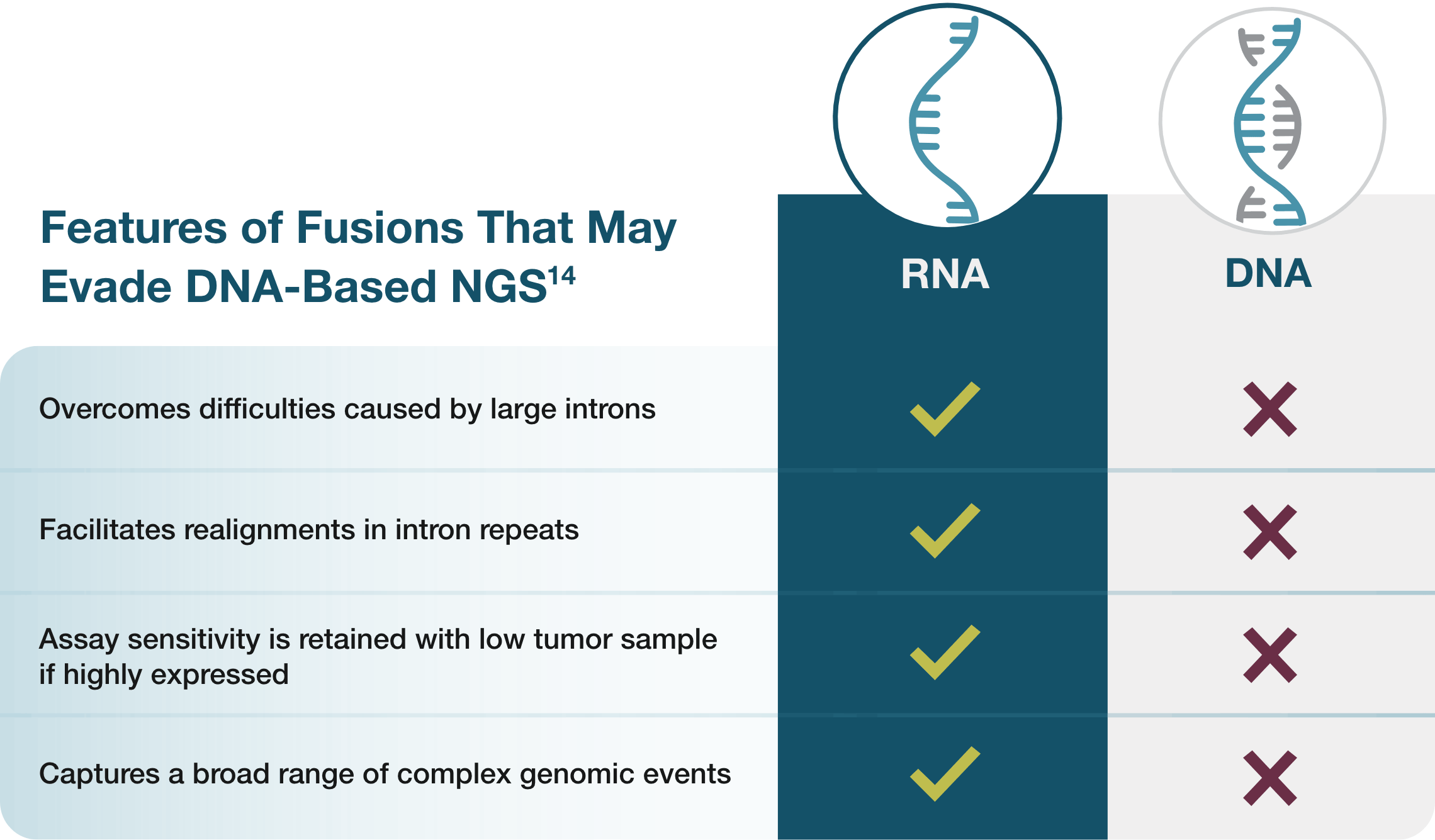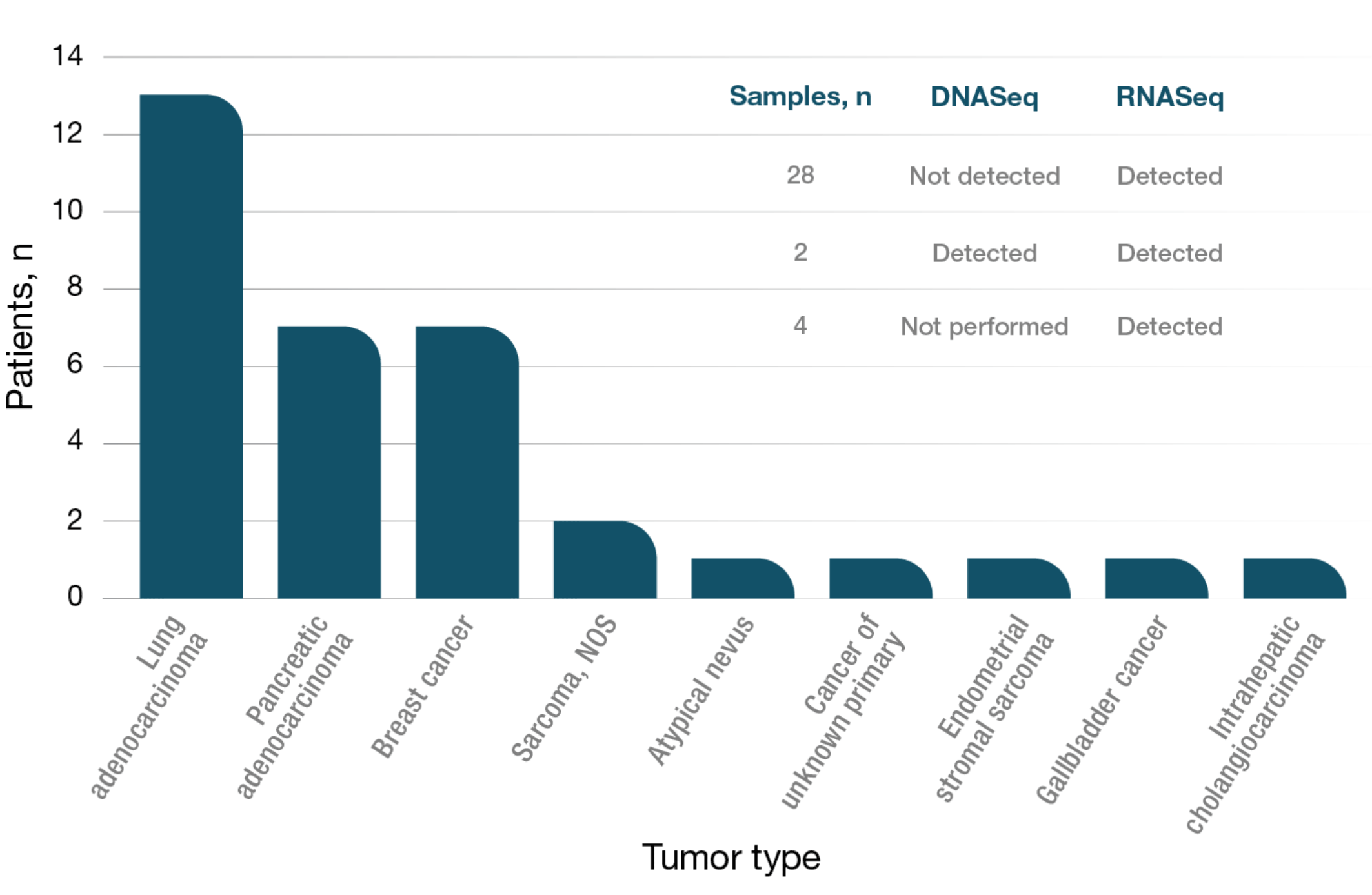Stay Informed


What is the optimal way to detect pathogenic gene fusions?
Conventional testing methods
An interesting sequence of facts
RT-PCR, FISH, and IHC are biomarker screening methods that were developed to detect single molecular targets and may fall short of detecting pathogenic gene fusions.1,2
- Inability to identify the full breadth of genomic alterations3
- Limited ability to identify the full breadth of fusion partners and breakpoints2
Sites of breakage when chromosomes break and recombine.
Source: GenScript. Accessed February 17, 2023. https://www.genscript.com/biology-glossary/8852/Breakpoint - May require a significant amount of tissue and can exhaust tissue samples4
Next-generation sequencing (NGS) can detect a broad range of genomic alterations5
NGS is a high-throughput genomic sequencing technology that allows for the simultaneous analysis of numerous alterations; NGS can be DNA-based, RNA-based, or both1,6
NGS Process7

Nucleic acid extraction
and isolation
and isolation

Fragmentation and
library creation
library creation

Amplifying and
sequencing the libraries
sequencing the libraries
DNA-based NGSDNA sequencing that can be used to find DNA changes that may cause cancer.
Sources: National Cancer Institute. Accessed February 17, 2023. https://www.cancer.gov/publications/dictionaries/genetics-dictionary/def/next-generation-sequencing. National Cancer Institute. Accessed February 17, 2023. https://www.cancer.gov/publications/dictionaries/cancer-terms/def/dna-sequencing alone can miss pathogenic gene fusions8
DNA sequencing that can be used to find DNA changes that may cause cancer.
Sources: National Cancer Institute. Accessed February 17, 2023. https://www.cancer.gov/publications/dictionaries/genetics-dictionary/def/next-generation-sequencing. National Cancer Institute. Accessed February 17, 2023. https://www.cancer.gov/publications/dictionaries/cancer-terms/def/dna-sequencing
Comprehensive testing with RNA-based NGSA high-throughput method used to determine a portion of the nucleotide sequence of an individual’s genome. RNA sequencing is used to learn more about which genes are expressed (turned on) in different types of cells.
Sources: National Cancer Institute. Accessed February 17, 2023. https://www.cancer.gov/publications/dictionaries/genetics-dictionary/def/next-generation-sequencing. National Cancer Institute. Accessed February 17, 2023. https://www.cancer.gov/publications/dictionaries/cancer-terms/def/rna-sequencing, including DNA and RNA sequencing, is recommended to capture what DNA-based NGS alone can miss1,8
A high-throughput method used to determine a portion of the nucleotide sequence of an individual’s genome. RNA sequencing is used to learn more about which genes are expressed (turned on) in different types of cells.
Sources: National Cancer Institute. Accessed February 17, 2023. https://www.cancer.gov/publications/dictionaries/genetics-dictionary/def/next-generation-sequencing. National Cancer Institute. Accessed February 17, 2023. https://www.cancer.gov/publications/dictionaries/cancer-terms/def/rna-sequencing

DNA-based sequencing can lead to false-negative and false-positive results in a variety of cases, particularly in the detection of gene fusions.8,9
aGraphic for illustrative purpose only. Not drawn to scale or reflective of actual results captured by the different methodologies.
bDNA-based NGS can detect some fusions not found by certain RNA-based NGS.9
Why is RNA-based NGS more comprehensive than DNA-based NGS alone for detecting pathogenic gene fusions?8,10
- RNA-based NGS detects gene expression and many structural variants11
- RNA-based NGS reduces many of the technical challenges involved in sequencing long introns11
The sequence of DNA that is initially copied into RNA but is cut out of the final RNA transcript and, therefore, does not change the amino acid code that determines protein structure. Some intronic sequences are known to affect gene expression.
Source: National Cancer Institute. Accessed February 17, 2023. https://www.cancer.gov/publications/dictionaries/genetics-dictionary/def/intron - RNA-based NGS enables oncologists to match therapy to the driving fusion, which wouldn’t have otherwise been identified, potentially leading to improved clinical responses8,12,13

Detecting NRG1 fusions15
- NRG1 fusions are more likely to be missed unless testing with RNA-based NGS
- The diversity of NRG1 fusion partners and breakpoints and their large intronic regions can make detection more challenging
In a retrospective study by the Memorial Sloan Kettering Cancer Center,
RNA-based NGS detected more NRG1 fusions than DNA-based NGS10
Both DNA-based and RNA-based NGS were performed on 30 IMA samples. Of these, 28 were detected by RNA-based NGS but not DNA-based NGS. The remaining 2 were detected by both. Four additional samples that did not undergo DNA-based NGS were detected by RNA-based NGS.
Detection of NRG1 Fusions Across Tumor Types (MSKCC Experience)10

Stay on the cutting edge of pathogenic gene fusions
Sign up to stay informed

FISH, fluorescence in situ hybridization; IHC, immunohistochemistry; MSKCC, Memorial Sloan Kettering Cancer Center; NRG1, neuregulin 1; NOS, not otherwise specified; RT-PCR, reverse transcription-polymerase chain reaction.
References: 1. Bruno R, Fontanini G. Next generation sequencing for gene fusion analysis in lung cancer: a literature review. Diagnostics (Basel). 2020;10(8):521. doi:10.3390/diagnostics10080521 2. Su D, Zhang D, Chen K, et al. High performance of targeted next generation sequencing on variance detection in clinical tumor specimens in comparison with current conventional methods. J Exp Clin Cancer Res. 2017;36(1):121. doi:10.1186/s13046-017-0591-4 3. Next-generation sequencing testing in oncology. Personalized Medicine in Oncology. Accessed January 27, 2023. https://www.personalizedmedonc.com/article/next-generation-sequencing-testing-in-oncology/ 4. Yu TM, Morrison C, Gold EJ, Tradonsky A, Layton AJ. Multiple biomarker testing tissue consumption and completion rates with single-gene tests and investigational use of oncomine Dx target test for advanced non–small-cell lung cancer: a single-center analysis. Clin Lung Cancer. 2019;20(1):20-29.e8. doi:10.1016/j.cllc.2018.08.010 5. Singh RR. Next-generation sequencing in high-sensitive detection of mutations in tumors: challenges, advances, and applications. J Mol Diagn. 2020;22(8):994-1007. doi:10.1016/j.jmoldx.2020.04.213 6. Goswami RS, Luthra R, Singh RR, et al. Identification of factors affecting the success of next-generation sequencing testing in solid tumors. Am J Clin Pathol. 2016;145(2):222-237. doi:10.1093/ajcp/aqv023 7. ABM Inc. Next generation sequencing (NGS) - data analysis. Accessed February 7, 2023. https://old.abmgood.com/marketing/knowledge_base/next_generation_sequencing_data_analysis.php 8. Benayed R, Offin M, Mullaney K, et al. High yield of RNA sequencing for targetable kinase fusions in lung adenocarcinomas with no mitogenic driver alteration detected by DNA sequencing and low tumor mutation burden. Clin Cancer Res. 2019;25(15):4712-4722. doi:10.1158/1078-0432.CCR-19-0225 9. Heydt C, Wӧlwer CB, Velazquez Camacho O, et al. Detection of gene fusions using targeted next-generation sequencing: a comparative evaluation. BMC Med Genomics. 2021;14(1):62. doi:10.1186/s12920-021-00909-y 10. Benayed R, Liu SV. Neuregulin-1 (NRG1): An emerging tumor-agnostic target. Clinical Care Options: Oncology. Accessed March 2, 2023. https://apps.clinicaloptions.com/oncology/programs/2021/nrg1-fusions/text-module/nrg1-text-module/page-1 11. Mahmoud M, Gobet N, Cruz-Dávalos DI, Mounier N, Dessimoz C, Sedlazeck FJ. Structural variant calling: the long and the short of it. Genome Biol. 2019;20(1):246. doi:10.1186/s13059-019-1828-7 12. Cobain EF, Wu Y-M, Vats P, et al. Assessment of clinical benefit of integrative genomic profiling in advanced solid tumors. JAMA Oncol. 2021;7(4):525-533. doi:10.1001/jamaoncol.2020.7987 13. Hindi I, Shen G, Tan Q, et al. Feasibility and clinical utility of a pan-solid tumor targeted RNA fusion panel: a single center experience. Exp Mol Pathol. 2020;114:104403. doi:10.1016/j.yexmp.2020.104403 14. Davies KD, Aisner DL. Wake up and smell the fusions: single-modality molecular testing misses drivers. Clin Cancer Res. 2019;25(15):4586-4588. doi:10.1158/1078-0432.CCR-19-1361 15. Drilon A, Duruisseaux M, Han J-Y, et al. Clinicopathologic features and response to therapy of NRG1 fusion–driven lung cancers: the eNRGy1 Global Multicenter Registry. J Clin Oncol. 2021;39(25):2791-2802. doi:10.1200/JCO.20.03307

